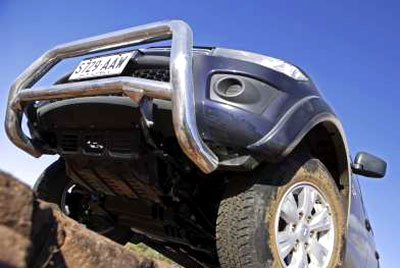Mitsubishi’s rugged Triton utility range has been further boosted by a raft of changes – topped by a new high-powered 2.5-litre common rail turbo diesel – to take the four-wheel-drive variants hauling into next year.
Muscle is a key to success in this work horse segment. Buyers respond to ‘tough’. In looks, character and performance.The 2.5, used previously in two-wheel-drive Tritons, has been upgraded. The numbers are not to be sneezed at – in manual form it knocks up a very driveable 131kW of power at 4000rpm and 400Nm of torque at a handy 2000rpm. This is up 11 percent and 17 percent respectively over the superseded 4M41 3.2-litre turbo diesel. The figures for the auto are 131 kW and slightly less torque – 350Nm.Fuel efficiency is part of the story too, with the manual managing 8.3litres/100km combined, and the auto 9.3.Scoring well in terms of output and efficiency was achieved by changes to the combustion chamber shape, improving the injectors, adding a variable geometry turbo charger and increasing boost pressure.On the road, and on a tough off road course which included many steep climbs, the new package felt responsive and capable.As for the rest of the 2010 line-up, the 2DW Tritons retain the 94kW/194Nm 2.4-litre petrol engine and 100kW/314Nm 2.5-litre diesel from the recent past. The petrol manual (10.4L/100km) can’t get close to either diesel engine variant. The 2.5 litre diesel in the 2WD Triton (admittedly pulling a lighter vehicle) manages 8.2 (manual) and 8.6 (auto).Two automatic trannies are available on the HP (for high performance) diesel variants – a four-speed carried over from the outgoing model is an option on all but the range-topping GLX Triton. The well-equipped GLX is fitted with an electronically-controlled five speed auto with sports mode.We should mention too that standard with the GLX is Mitsubishi’s All Terrain Technology (MATT) featuring the Super Select four-wheel-drive system which includes stability and traction control, multi-mode ABS and optional factory diff lock.Owners will also welcome Mitsubishi’s response to feedback which reflected consumer clamour for improved load carrying and towing abilities with the work-and-play vehicles. The new long-bed tray available on dual cab Tritons have been improved by 14 percent to a tray length of 1505mm and tray height of 460mm. Towing capacity has been boosted too.These days of course, vehicle makers can’t get away with going soft on safety. The new Triton shares a good four-star crash rating with one other competitor – the Toyota Hi Lux. All 2010 Tritons get standard front airbags, anti-skid brakes with electronic brakeforce distribution, and front belt pretensioners.The new range also gets some subtle styling improvements inside (seat fabric and seat pads, instrument panel, audio upgrade) and out (bumpers, grille and side turning lamps).With the launch of the 2010 range, Mitsubishi has simplified the variants to make consumer choice simpler.Eight 2WD variants are petrol manual GL cab chassis and GLX dual cab, and auto or manual diesel GLX cab chassis and dual cab, and GL-R dual cab.The new HP 2.5 diesel is available to power 4WD models in either manual or auto in GLX single cabs and dual cabs, GL-R dual cabs or GLX dual cabs.Prices reflect Mitsubishi’s determination to remains popular in the archly competitive segment.The base GL 4 x2 stays at $20,990. The most expensive model in the catalogue is the 2.5 diesel GLX-R double cab pick-up 4 x 4 at $47,990 (or another $2500 for the auto).The $35,490 GL-R slots into a new price class for Mitsubishi.





